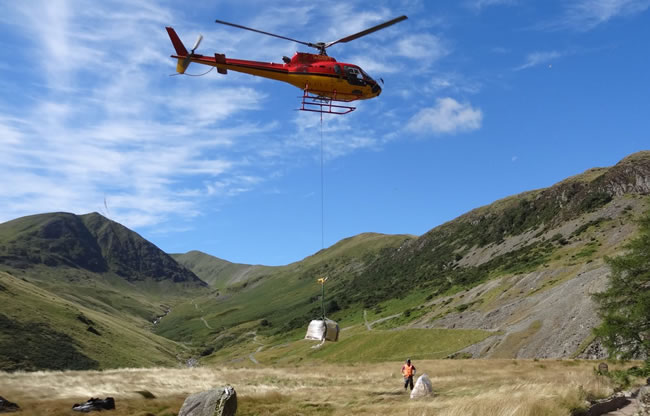By Concrete Canvas – In August 2016, a Concrete Canvas® Geosynthetic Cementitious Composite Mat (GCCM) was used to line a drainage channel at Glenridding Mine, Ullswater, Cumbria. The objective was to re-line an existing 200m long channel on top of a tailings dam to prevent damage from runoff during severe rain storms. In recent years there have been a number of extreme rain storms in the Lake District, such as Storm Desmond, which require adaptations and drainage improvements to be made.

The project was managed by the Lake District National Park Authority with significant support from the 7 5 Engineer Regiment under 4 2 Brigade, design input from the Coal Authority and from the Environment Agency. The installation was completed over a 10-day period, in mostly clear weather.
CHANNEL LINING APPROACHES
Various methods have previously been used to line the channel, including dry stone walling and poured concrete. The Coal Authority, who provide geotechnical advice to the Lake District National Park Authority recommended the use of Concrete Canvas®. CC is a cement-impregnated geotextile that hardens on hydration to form a durable, fibre reinforced, impermeable concrete layer. The material can be deployed by hand from man portable batched rolls or from large bulk rolls mounted on spreader beam equipment for larger projects and where plant is available. CC can be cut to the exact section of any given channel, eliminating waste and accommodating variations in profile. CC’s main advantages over conventional concrete are speed and ease of install, cost savings, durability and environmental friendliness.

RELATED: Zinc and Copper Mine Gets Largest GCCM Installation to Date
Greenside Mine was at one time the UK’s largest producer of lead ore and is now designated a Scheduled Monument as a result of over 150 years of continuous operation and evidence still being visible on the ground of the different mining techniques deployed over that time. Above the tailings dam, the natural scree habitat is designated as SSSI for species such as Juniper, rare mosses and ferns including the Parsley Fern.
Being such a sensitive location, arranging permitting was essential for planning permission, Environment Agency Licensing, LFRM, Scheduled Monument and SSSI Consent. This very complex permitting procedure, carried out by the Lake District National Park Authority, was made much easier through the use of CC rather than poured concrete. The fact that it could be installed by hand meant that (a) it was feasible, and (b) there was a very small on-the-ground footprint during deployment. Without the issue of re-bound that is present in more conventional construction methods such as shot-crete, CC proved to be a far more environmentally friendly option.
TAILINGS DAM DRAINAGE IMPROVEMENT
The mine site is on a steep hillside, two miles up a remote track. This presented a number of logistical issues in regards to delivery. With no possibility of off-loading on the tailings dam site, the project manager organized delivery of palletized material by HIAB wagon to a point 500m away, with pallets then being flown into position by commercial helicopter. The rolls of CC8TM were batched to specific lengths to accommodate the different profile the channel takes along its 200 metre length. Concrete Canvas ensured that the man-portable batch rolls, were all labelled correctly and palletised to the customers’ requirements into loads that each weighed less than 950kg, allowing them to be subsequently lifted and accurately positioned by helicopter.

Getting the logistics correct was key to enabling a rapid delivery and the success of the project. With no wheeled or tracked machinery able to access the site, correctly positioning the pallets by helicopter meant the volunteer Army workforce was then able to focus on the installation of CC in the channel rather than waste time moving materials by hand.
Removal of some of the dry stone walls and overburden on one side of the channel took place prior to installation. The CC was trimmed using knives, and anchored to the ground using steel pegs and heavy rocks. The overlaps were jointed using stainless steel screws at 200mm centers. An army issue portable temporary 10,000 liter reservoir was used for hydration.

Learn more about Concrete Canvas applications at www.concretecanvas.com.
See also:











